I am trying to imagine a tree sort of system where you have tree nodes which can have powers of 2 nodes up to 32 nodes each. The data is stored in "leaves", and the leaves are bundled into power of 2 up to 32 nodes likewise. What I'm thinking is that upon insert, if the leaf node is 32 nodes, then you split it in half, add those two halves to a new parent, and add that to the tree. The problem is, if you keep inserting in the same place, I could see this sort of tree emerging, where it splits the same sort of place over and over again, resulting in a deep branch, as each leaf reaches 32 items.

If each of those leaf nodes represents up to 32 items each, and each internal container node can contain up to 32 sub-containers/leaves each, how can I use rotation to balance this tree? The problem is I don't know how the final tree would look, so I don't know how the rotation should work. I try to imagine it but don't get there.

Animated tree rotations are all pretty basic and don't show how to do it on non-binary trees.
Since the nodes could have up to 32 nodes, a deeply nested tree should end up looking something like this (say the first layer I actually drew 32 nodes, so it was full):

I'm not sure exactly what it should look like, which is the reason for this question. But as you insert nodes in the tree, the thing should somehow rotate so it doesn't get long branches like the ones above, yet each node can have up to 32 children (or objects/items if they are the leaf type). Is this at all possible? If so, what is some JavaScript for how to implement the rotation to keep this n-ary tree "balanced" like a BST?
Sidenote. I am trying to tinker with a rotation scheme, but not getting very far.
// split()
// rotate() // shift
const createTree = () => createTreeLeaf()
const createTreeContainer = () => {
return {
type: 'container',
list: [],
size: 0
}
}
const createTreeLeaf = () => {
return {
type: 'leaf',
list: [],
size: 0
}
}
const insertAt = (tree, index, item) => {
if (tree.size == 0) {
tree.list.push(item)
tree.size++
return tree
}
let nodes = [tree]
let startSize = 0
a:
while (true) {
b:
for (let i = 0, n = nodes.length; i < n; i++) {
let node = nodes[i]
let endSize = startSize + node.size
if (startSize <= index && index < endSize) {
// it's within here.
if (node.type == 'container') {
nodes = node.list
break b
} else {
let relativeIndex = index - startSize
// grow if less than max
if (node.size == 32) {
const firstHalf = node.list.splice(0, 16)
const secondHalf = node.list.splice(-16)
const container = createTreeContainer()
const aNode = createTreeLeaf()
aNode.list.push(...firstHalf)
aNode.size = 16
const bNode = createTreeLeaf()
bNode.list.push(...secondHalf)
bNode.size = 16
container.list.push(aNode, bNode)
container.size = 32
container.parent = node.parent
node.type = container.type
node.list = container.list
node.size = container.size
i--
continue
} else if (node.size && relativeIndex > node.size - 1) {
let newArray = new Array(node.size * 2)
node.list.forEach((x, i) => newArray[i] = x)
node.list = newArray
}
let j = node.size
while (j > relativeIndex) {
node.list[j] = node.list[j - 1]
j--
}
node.list[relativeIndex] = item
node.size++
break a
}
}
}
}
}
let tree = createTree()
for (let i = 1, n = 2000; i <= n; i++) {
insertAt(tree, 0, i)
}
console.log(JSON.stringify(tree))Currently ending up with a deep tree, not sure how to implement this rotation.
If there is an alternative to using rotation as well that will create a balanced tree, that would also be a suitable answer.






